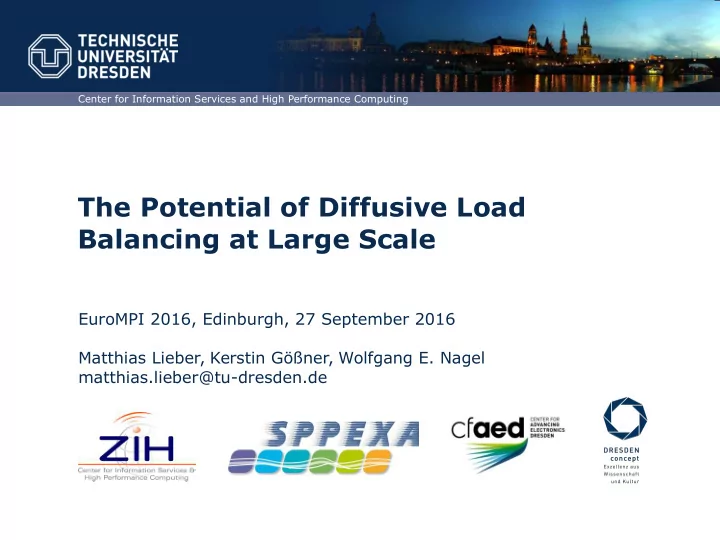

Center for Information Services and High Performance Computing The Potential of Diffusive Load Balancing at Large Scale EuroMPI 2016, Edinburgh, 27 September 2016 Matthias Lieber, Kerstin Gößner, Wolfgang E. Nagel matthias.lieber@tu-dresden.de
Motivation: Load Balancing Load Balance • A challenge for HPC at large scale • Especially for applications with workload variations Goals of load balancing Repartition application to balance workload • • Reduce comm. costs between partitions (edge cut) • Reduce task migration costs • Fast & scalable decision making Particle density, laser wakefield acceleration simulation with particle-in-cell code PIConGPU Slide 2
Motivation: Diffusive Load Balancing Fully distributed method Cybenko, • Local operations lead to global Dynamic Load Balancing for Distributed Memory convergence Multiprocessors, J. Parallel Distr. Com. 7(2), 1989. Load per node over iterations Watts, Taylor, Practical application is rare IEEE T. Parall. Distr. 9, 1998. Diekmann, Preis, Schlimbach, • Well described since the 1990's Walshaw, Parallel Computing 26(12), 2000. • Only few papers show real use in HPC Schloegel, Karypis, Kumar, SC 2000. Motivation of this work • Performance comparison to other state-of-the-art methods at large scale Slide 3
Contents Motivation • Load Balancing • Diffusive Load Balancing Short Diffusion Intro Concept • • Algorithms Performance Comparison • Benchmark Setup • Other Methods • Results Slide 4
Short Diffusion Intro Concept • Arrange processes/nodes in a graph G , e.g. mesh • Balance virtual load with neighbors for several iterations until global convergence • Result: minimal* load flow between neighbors in G that leads to global balance How to realize the flows? • 2nd step required: task selection • Satisfy flows best possible, keep edge cut and migration low (to reduce communication) * Most methods minimize sum of squares of individual flows between nodes (two-norm) Slide 5
Short Diffusion Intro: Algorithms Original Diffusion Algorithm (Orig Diff) Cybenko, J. Parallel Distr. Com. 7(2), • In each iteration i each node v updates its 1989. i + ∑ i − l v i ) load: i + 1 = l v α vw ( l w l v Estimation: w ∈ N v l v ... load value of node v One iteration N v ... neighbor nodes of node v should take few 10 µs only α vw ... diffusion parameter Second Order Diffusion (SO Diff) Muthukrishnan, Ghosh, Schultz, • Prev. iteration‘s transfer influences current Theory Comput. Sys. 31, 1998. Improved Diffusion (Impr Diff) Hu, Blake, Parallel Computing 25(4), • Update rule is adapted during iterations 1999. based on Laplacian matrix of graph G Dimension Exchange (Dim Exch) Cybenko, 1989. Xu, Monien, Lüling, Lau, • Local load is updated immediately before Conc. Pract. E. 7, 1995. exchanging with next neighbor Slide 6
Contents Motivation • Load Balancing • Diffusive Load Balancing Short Diffusion Intro Concept • • Algorithms Performance Comparison • Benchmark Setup • Other Methods • Results Slide 7
Performance Comparison: Diffusion Benchmark Benchmark setup • 3D task grid, 3D process mesh, 512 tasks per proc • Artificial imbalanced workload data* • Iterations terminate at target imbalance of 0.1% 2D grid example of BOX scenario Red part is overloaded such that imbalance is 11% (i.e. max load / avg load - 1) Simplifications • Time measurement w/o checking termination criterion • Simple task selection algorithm (single pass) * in the paper we also use the particle-in-cell application szenario Slide 8
Performance Comparison: Other Methods Zoltan load balancing library http://www.cs.sandia.gov/Zoltan Boman, Catalyurek, Chevalier, Devine, • MPI-based library implementations The Zoltan and Isorropia Parallel Toolkits for Combinatorial Scientific Computing: Partitioning, Ordering, and • RCB: recursive coordinate bisection Coloring, Scientific Programming, 20(2), 2012. • HSFC: Hilbert space-filling curve Schloegel, Karypis, Kumar, • ParMetis graph partitioning via Zoltan A Unified Algorithm for Load-balancing Adaptive Scientific Simulations, SC 2000. Hierarchical space-filling curve • Own fast and scalable method Lieber, Nagel, S calable High-Quality 1D Partitioning , • Leads to high migration HPCS 2014. Slide 9
Performance Comparison: 1Ki-8Ki weak scaling Max number of Iterations until task mesh edges Median run time of 61 runs on flows lead to Max tasks cut by partition Taurus, Intel Haswell + Infiniband 0.1% imbalance = max ( l v ) avg ( l v ) − 1 sent+received borders among FDR cluster with Intel MPI, (before task among all procs all procs error bars show 25/75 percentiles selection) • Diffusion leads to smallest migration • Diffusion achieves very good edge cut • Diffusion run time ca. 2 ms for 8192 processes, Zoltan much slower Slide 10
Performance: 8Ki-128Ki, without task selection Max / total load transfer Median run time of 19 runs on Iterations until computed by diffusion relative to Juqueen, IBM Blue Gene/Q, flows lead to to avg / total load of procs error bars show 25/75 percentiles 0.1% imbalance • Dimension exchange scales better than second order diffusion • Diffusion takes few ms even on 128k processes* * task selection time does not depend on process count and takes few ms on Juqueen Slide 11
Summary Conclusion Diffusive load balancing is attractive on large scale when overhead (time for decision making, task migration) has to be low, e.g. in case of frequent rebalancing. Future work • Improve task selection • Scalable termination criterion: estimate required iterations or check convergence? • Optimal process graph topology: match the hardware or the application? • Add to Zoltan / Charm++ / application XYZ Slide 12
Thank you very much for your attention Acknowledgments / Funding: Slide 13
Recommend
More recommend